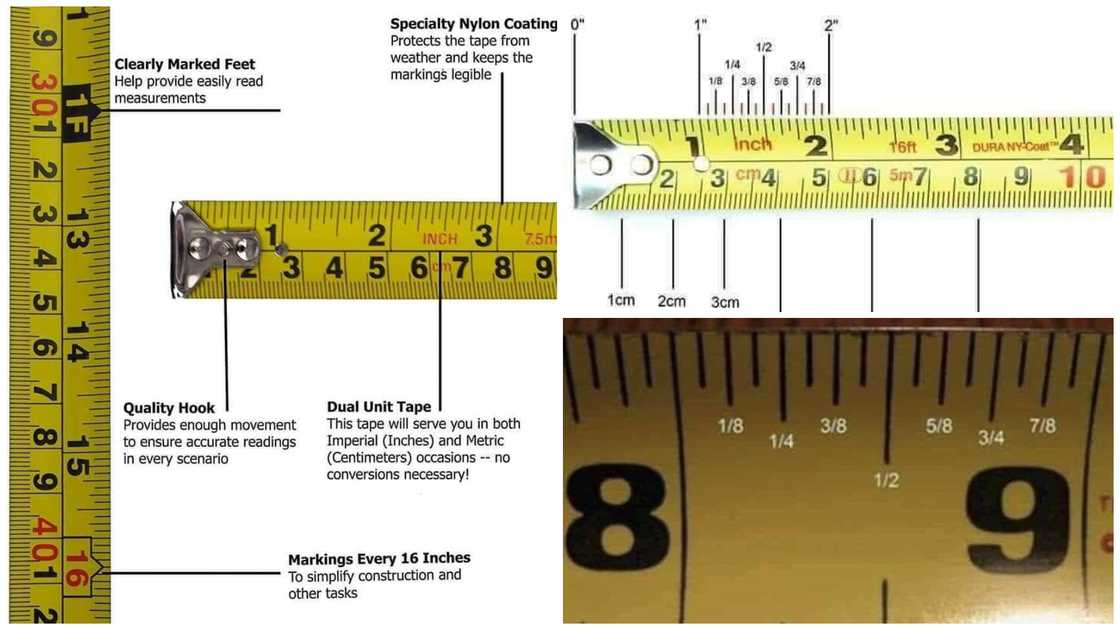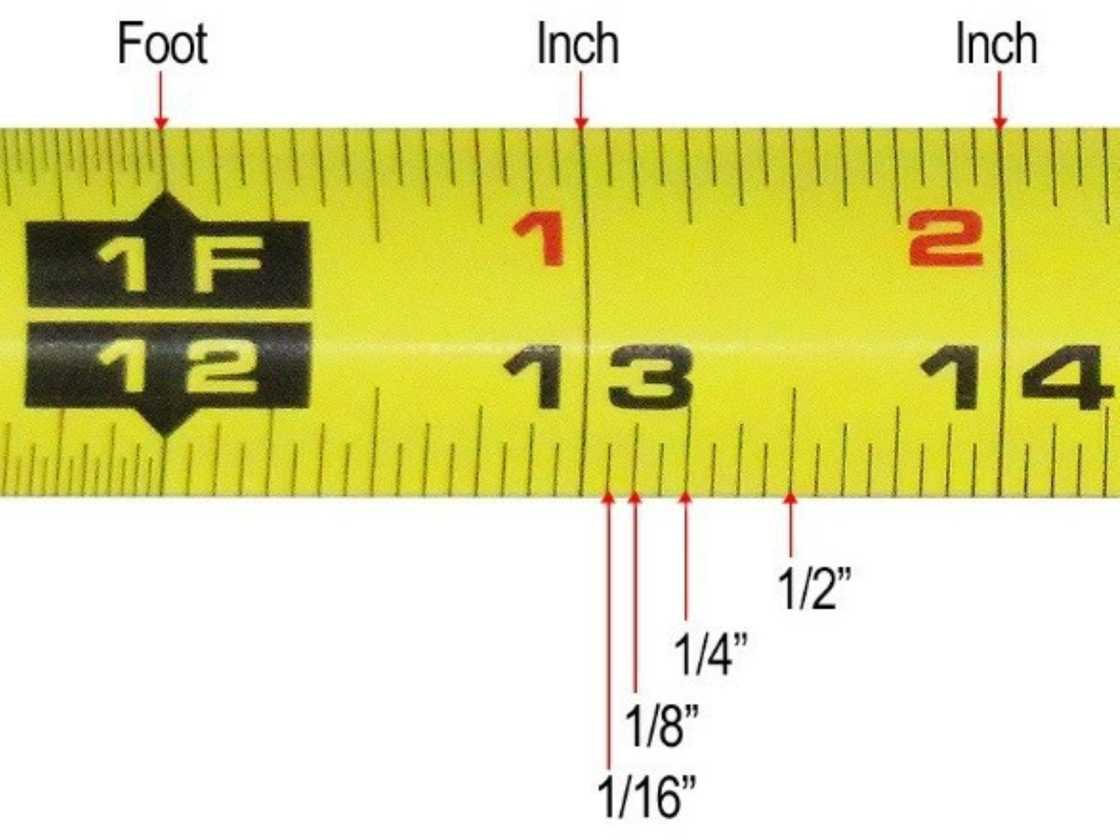Full guide on how to read a tape measure in inches and centimetres (with photos)
In life, learning certain levels of craftsmanship could come in handy. For example, learning how to read a tape measure correctly can help you in various DIY projects. Though it might seem straightforward, reading the tape measure can prove challenging to most people.

Source: UGC
A tape measure is a flexible ruler used to measure length or distance. It comes in various materials, including plastic, fibreglass, a cloth ribbon or the most common, metal strip. It is a standard measuring tool used in constructions with linear measurement markings.
How to read a tape measure
If you want to learn how to read a tape measure correctly, you should know the meanings behind its markings. Most tape measures contain markings on the top and the bottom. The markings on the top row are for measuring imperial units (inches and feet). The markings on the bottom row are for the metric units (centimetres and meters).
Imperial units (inches and feet)

Source: UGC
The imperial unit (inches and feet) is an old-school measuring unit still adopted in the United States. The imperial measuring unit is on the top row of the measuring tape, marked with varying black lines and arranged in numerically ascending order.
Imperial measurements use fractional denominations, e.g. 1/2s, 1/4s, and 1/8s, with the 12 inches mark equalling one foot.
How to read a measuring tape in inches
Inches are the most prominent markings on the tool, numbered in ascending order. The spaces from one inch to the other represent fewer inches.
- Pull out your measuring tape and find the longest, numbered lines to measure full inches. The length from one of the most extended lines to the next one of the same size is always 1 inch.
- Use the second most extended marks to measure half-inch increments. The half-inch mark is centred between the long lines, marking out full inches. Therefore, unless it's the first half-inch mark, always add the full inch that came right before it to the measurement. For example, two plus half an inch is 2 and 1/2 inches.
- The third longest line in the inch imperial unit is the quarter-inch. The quarter inch is at the centre of the half-inch and full-inch lines with shorter markings than the half-inches.
- The fourth most extended lines comprise the eighth-inch increments. They are the fourth shortest markings between each quarter-inch line containing eight eighth-inch increments.
- If measuring the smallest margins, use the sixteenths of an inch. Most standard tape measures go up to the 1/16 margin. The 1/16-inch is half of the 1/8-inch.
Note: There are some precise tape measures with 1/32-inch or 1/64-inch.
How to read a tape measure in feet

Source: UGC
Feet are on the same row as inches but marked in intervals of 12 inches (12 inches equals 1 foot).
- To measure feet, look for coloured markings on the 12th-inch mark. Some tape measures have unique symbols like the letter F to represent one foot.
- If measuring half a foot, use the sixth-inch mark as a reference point.
Metric units (centimetres and metres)

Source: UGC
The metric unit (centimetres and metres) is a modern measuring unit standard worldwide. The metric unit uses decimal points instead of fractions in units of 10, 100, 1000, 1/10, 1/100, 1/1000.
How to read a tape in centimetres
Which is CM on a tape measure? It is part of the metric units (centimetres and metres) markings on the bottom of your tape measure. The centimetre is the most prominent marking characterised by numbers (alongside significant markings) in ascending order. One centimetre equals 10 millimetres, while 100 centimetres make one metre.
- To measure using the centimetres (CM), look for the most prominent markings with numbers at the bottom. The numbers are in ascending order with noticeable markings every 10 centimetres.
- Use the second most extended lines on the bottom side of your tape to measure half-centimetre increments. The metric system is in base ten, making it much easier to work with decimals than fractions in imperial measurements. E.g. 0.5 centimetres (cm) instead of half (½) centimetres.
How do you read the tape in metres?
The metre mark is at the bottom of your tape measure on the 100 centimetres mark. Some measuring tapes have a unique coloured marking or the letter M to represent the metre mark. Use the 100 cm mark as a reference point if it is not marked.
- Locate the M marking, sometimes in red, at the bottom of your measuring tape on the centimetres section.
- To measure half a metre, locate the half-metre mark or the 50-centimetre point as a reference.
How to read a tape measure in mm
The millimetres is the most minor and most dense marking of the bottom side of your measuring tape. Each mm equals one-tenth (1/10) of a centimetre or 0.1 centimetre (10 millimetres per centimetre).
- To measure millimetres (mm), find the nearest whole centimetre to the endpoint.
- Read between each mark with every short mark as one millimetre. The fifth mark is typically longer to help you find the half-centimetre easily.
How to read a tape measure for dummies

Source: Getty Images
Below is a cheat sheet on reading a tape measure using basic knowledge of the workings of a standard measuring tape.
- Find the read markings with the most significant numbers to identify the inches.
- As the increments increase, so does the length of the mark. For example, 1/8 is smaller than 1/4, and 1/2 is smaller than 1 inch.
- Find the length by adding the sizes between inches together. If a measurement goes beyond the space between two-inch marks, add the length of that inch with the distance between the second-inch mark and the third. For example, add 1 inch and 1/4 inch to get 1¼ inch.
- Add the known fractions to find the length for lengths that go from the inch mark to the unlabeled marking. For example, a measurement that is between 3/4 and 7/8.
- Since the difference between 3/4 and 7/8 is 1/8, a marking between the two numerals is 1/16, half of 1/8. Convert 3/4 to 12/16 for common denominators and add 12/16 + 1/16 to get your length of 13/16.
What do the lines on a tape measure mean?
The markings on the top row of the measuring tape represent the imperial units of inches and feet, with the numbering corresponding to the inches. The markings on the bottom indicate the metric units of centimetres and metres.
The most prominent marks (on the bottom) represent the centimetres, while the long pattern in the centre shows a half-centimetre. The tiniest marks/densely packed lines indicate one millimetre or 1/10th centimetre.
Unique markings (double arrows and diamond truss marks)

Source: UGC
The other unique markings on the professional tape measures are the double arrows and the diamond truss marks. The double needles are on the 16-inch point to mark the standard distance between wall studs. The black diamond, every 19.2 inches, is used in installing roof trusses in construction.
Do you know how to read a tape measure? The guide above provides instructions on how to read it in inches and centimetres. The guide also includes directions about the various unique markings on the tape measure, including red markings and black diamond shapes.
Yen.com.gh published about the average shoe size for men. There may be differences in shoe size depending on where you are. For instance, the standard footwear measurements for men in the USA may differ slightly from those in Europe.
What is the most common shoe size? The average shoe size for men generally depends on various aspects, including age, height, weight and foot condition. But what else determines a person's shoe size?
Source: YEN.com.gh







